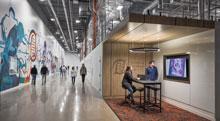
The Workplace of the Future
STUDENTS LEARN TO BE COMFORTABLE WITH AMBIGUITY.
BY DOMINIC IACOBUCCI AND AARON BRADLEY
WHAT’S THE BEST way to prepare students for the rapidly changing workplace of the future? Teach them to address complex problems through ideation and creative problem-solving techniques. And, most important, help them recognize that some problems have no easy—or right—answers.

Students use collaborative design thinking exercises to generate and organize new ideas.
That’s the approach of Inquiry to Innovation: The Future of Work, a transdisciplinary honors class at the University of Cincinnati (UC) in Ohio. In the class, which was launched in 2013, students consider topics ranging from autonomous vehicles to workplace diversity to contract-based work environments. The semester culminates with a showcase of the students’ research insights, implications, and actionable solutions.
The university developed Inquiry to Innovation in partnership with BHDP Architecture, which sponsors the course and outlines deliverables for each semester. Up to 24 students can enroll in each 15-week course, which is considered a professional elective for several departments at the university. Classes meet in a variety of campus locations—including UC’s 1819 Hub, a 100,000-square-foot building that includes makerspaces, classrooms, and gathering spaces—as well as BHDP’s offices. Classes are taught by both UC faculty and creative leaders from BHDP.

Facing workplace ambiguities, students address challenges and potential solutions for the workplace of the future.
A typical class meeting might start with a theoretical discussion related to the project, followed by timed rapid ideation and brainstorming exercises to stimulate ideas. As they brainstorm, students might use a word association or visualization exercise related to the discussion topic. Over the course of the semester, students will employ design thinking, ethnographic research, and rapid ideation techniques to look beyond their initial thoughts and biases to consider the impact of factors such as cultural norms and societal trends. Other techniques, such as building relational or journey maps, help students visualize and communicate abstract ideas. In addition, students examine situations and products unrelated to the future of work for sources of analogous inspiration.
Throughout the course, students work in interdisciplinary teams, where they learn the value of exposure to perspectives of people from a range of different backgrounds. Students consistently report that interacting with a diverse group of individuals is their favorite part of the experience.
A main objective of the course is helping students become comfortable with ambiguous situations where there is no one right answer. Many students find it challenging and uncomfortable to embrace ambiguity in this manner, but it’s a skill they need to develop if they are to push past boundaries to address complex problems and succeed in a rapidly changing society.
Another objective of the course is to encourage students to consider real-world challenges that might have major implications in the future workplace. This is an area where co-teachers from BHDP can really share their expertise, making the course a more meaningful experience for both students and businesses.

Students’ final presentations offering insights, implications, and actionable solutions.
In the academic world, students are used to taking specific and concrete steps to complete final projects, papers, or exams. In the professional world, many problems do not have clear-cut processes or answers. By teaching students to use creative problem solving, ideation, research, and cross-disciplinary teamwork to solve problems, Inquiry to Innovation prepares students to succeed in a rapidly changing professional world.
Dominic Iacobucci is a workplace client leader and partner at BHDP Architecture in Cincinnati, Ohio. Aaron Bradley is an associate professor of the Design and Arts Initiative at the University of Cincinnati.
This article was originally published in BizEd.
